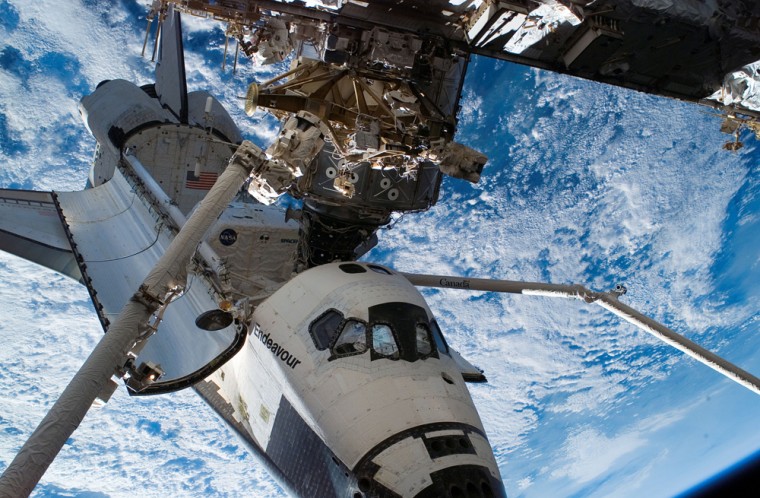Worried that Hurricane Dean might blow its way, Mission Control considered scaling back Saturday’s spacewalk at the orbiting shuttle and station complex to allow for a possibly early end to Endeavour’s mission.
NASA wants to keep its options open for moving up Wednesday’s shuttle landing by one day, and shortening the spacewalk would be one way to do it, said Le Roy Cain, a ranking member of the mission management team.
Shuttle managers also decided Friday to put off fuel-tank preparations for the next launch until engineers decide how to best solve the latest foam-loss problem. A piece of foam, ice or a combination of both broke off the tank during Endeavour’s launch last week and shot into the shuttle’s belly, carving out a deep gouge that triggered a week of furious thermal analyses.
Cain said the redesign to the area in question probably will not delay the next mission, currently targeted for October, but could well postpone some of the flights after that.
Much of Saturday’s spacewalk — the fourth and final outing of Endeavour’s two-week mission — involves space station chores that could be put off, Cain said. The two designated spacewalkers will know what’s expected of them well before they float out the hatch at midmorning, he said.
Hurricane Dean is currently aiming for Mexico’s Yucatan Peninsula. If it looks like the storm might veer toward Houston, Mission Control could be forced to relocate to Kennedy Space Center in Florida. The operations at Cape Canaveral would not be as good and there would be fewer controllers, which is why NASA probably would opt to bring the shuttle home a day early.
Another option, although less likely, would be to keep the shuttle at the international space station longer than planned.
Endeavour is currently scheduled to undock from the space station on Monday.
As NASA kept a sharp eye on Dean, the astronauts geared up for Saturday’s spacewalk to install some more equipment outside the space station. The two spacewalkers will be extra careful, avoiding any sharp edges, so they don’t rip a glove and have to rush back inside. They also will frequently check their gloves for any damage.
Wednesday’s spacewalk was cut short when astronaut Rick Mastracchio noticed he’d pierced the thumb of his left glove. The slit penetrated only the top two layers of his five-layer glove.
Relieved by decision to skip repair
On Friday, Mastracchio and his fellow astronauts said they were relieved by NASA’s decision to skip repairs to the deep gouge on their spaceship’s belly, and noted it would have been tough to pull the job off.
“We were not looking forward to doing it only because there was a lot of risk involved,” said Mastracchio, who would have been the main repairman.
It would have been difficult to prepare all the tools and get to the gouge on Endeavour’s underside, Mastracchio said. The actual repair — applying black paint and caulk-like goo to the crevice — would have been the shortest part, he said.
Endeavour’s commander, Scott Kelly, said the crew was concerned about potentially causing more damage to the underside of the shuttle. All seven shuttle astronauts and even the three crewmen on the international space station supported the decision, he noted.
“We agree absolutely 100 percent with the decision to not repair the damage,” Kelly said in a news conference from space.
Decision not unanimous
Thursday night’s decision by mission managers was not unanimous. Some engineers at Johnson Space Center in Houston, home to Mission Control, thought it would be prudent to send Mastracchio and another crewman outside to patch the 3.5-inch-long, 2-inch-wide (9-by-5-centimeter) gouge.
But mission managers and most everyone else shared Kelly’s view that the damage — well understood and by no means catastrophic — could have been made worse by a fix that was, in fact, unnecessary.
The repair debate and analyses on the ground dragged on for an entire week. The concern was not that Endeavour might be destroyed like Columbia was in 2003, but rather that heat exposure during re-entry might weaken the aluminum frame and require lengthy post-flight repairs.
“I, for one, am happy they took as long as they did,” Kelly told reporters.
Both Kelly, a Navy commander, and his co-pilot, Marine Col. Charles Hobaugh, said they do not expect any extra tension in the cockpit when it comes time to bring Endeavour home. On board will be teacher-astronaut Barbara Morgan, who was Christa McAuliffe’s backup for Challenger’s doomed flight in 1986.
“We gave this a very thorough look and I am very, very comfortable and there will be no extra concern in my mind due to this damage,” Kelly said.
The debris that broke off Endeavour’s tank weighed just one-third of an ounce (10 grams) and consisted of foam insulation, ice or both. Foam has come off that same part of the tank — a bracket that holds the liquid oxygen feed line in place — on previous flights.
“It’s a serious problem for us and ... we need to go resolve it before we fly the next mission,” Cain said.
